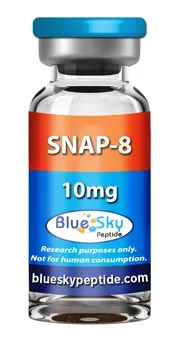SNAP-8 Peptide for In Vitro Research – SNAP-8, also known as acetyl glutamyl heptapeptide-1, is a synthetic neuropeptide specifically designed for in vitro laboratory research. Composed of 8 amino acids and with a molecular weight of 1074.5 g/mol, SNAP-8 is based on the N-terminal sequence of the SNAP-25 peptide. This research peptide has shown potential in in vitro studies focused on anti-wrinkle and muscle relaxation mechanisms, making it a popular choice for cosmetic and anti-aging peptide research under laboratory settings only.
Mechanism of Action in Laboratory Research
In laboratory research, SNAP-8 interacts with the SNARE complex, specifically affecting syntaxin and synaptobrevin, which are crucial for cellular transport and vesicle fusion. This peptide functions similarly to SNAP-25 but destabilizes the SNARE complex slightly, reducing neurotransmitter release. This results in decreased muscle contractions, an effect studied in vitro for its relevance in anti-wrinkle peptide research.1
Preclinical Animal Research Findings
Preclinical animal studies have suggested that SNAP-8 may support skin relaxation and potentially serve as a model alternative for studying botulinum toxin effects in controlled environments. However, it is important to note that SNAP-8 peptide is for laboratory research only and is not approved for human or veterinary use.2
In Vitro Cosmetic Research Results
In a specific in vitro study, 17 subjects’ eye wrinkles were assessed over 28 days using a 10% SNAP-8 formulation. Silicon imprints measured the wrinkle reduction effect, resulting in a maximum improvement of 62% and an average improvement of 35%. These findings support its role in in vitro cosmetic peptide research but are limited strictly to laboratory conditions.3
Product Availability and Compliance Notice
Blue Sky Peptide’s SNAP-8 is available in a lyophilized white powder form with a concentration of 10 mg per vial. It is intended exclusively for in vitro scientific research and must not be used on humans or animals outside of laboratory studies.
References:
1. Han J, Pluhackova K, Bockmann RA. The Multifaceted Role of SNARE Proteins in Membrane Fusion. Front Physiol. 2017;8:5.
2. Gutierrez LM, Viniegra S, Rueda J, et al. A Peptide That Mimics the C-terminal Sequence of SNAP-25 Inhibits Secretory Vesicle Docking in Chromaffin Cells. J Biol Chem. 1997;272(5):2634-9.
3. Wongrattanakamon P, Nimmanpipug P, Sirithunyalug B, Jiranusornkul S. Molecular modeling elucidates the cellular mechanism of synaptotagmin-SNARE inhibition: a novel plausible route to anti-wrinkle activity of botox-like cosmetic active molecules. Mol Cell Biochem. 2018;42:97-109.


